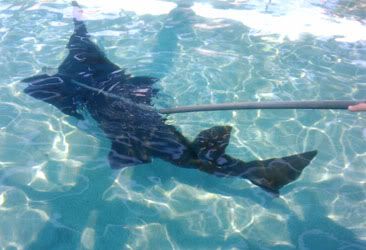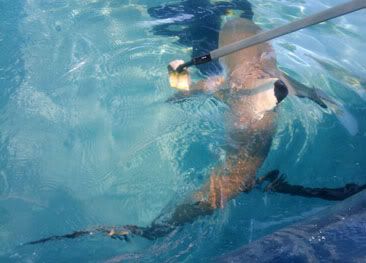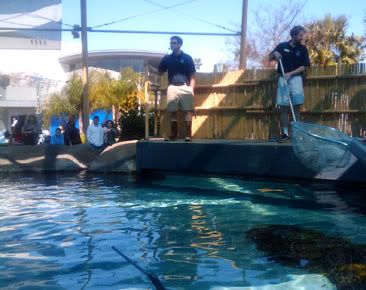
Kari Olson is mad at Barbara, an eight-foot whitetip shark in the Aquarium of the Pacific Shark Lagoon. The shark specialist is trying to feed the tank’s sawfish, a large but timid predator who has to be fed at a particular angle because of its large bill. But Barbara is the bully of the playground, darting through the water and stealing the mahi-mahi chunk off the feeding stick.
“They’re like my kids,” Olson laughs. “You can tell which ones I’m mad at.”
There is no such thing as a “Typical Day” for Olson, who works in the husbandry unit at the Aquarium of the Pacific—the fifth largest aquarium in the nation. She starts her day by making rounds, meaning she observes the sharks’ activities and interactions, making sure that all eyes and gills are intact and ready for presentation.
“Sharks are incredible hunters and should be respected,” she says. She desires all people to be informed about these creates and when a connection is made it equals involvement. The tricky part is balancing the connection with respect. “These are not cuddly animals that can be touched in the wild,” she added.
While overseeing the sharks, she checks to ensure that all exhibits are looking good, which entails removing the bamboo shark eggs. One bamboo shark can lie up to fifty eggs in one year, and Olson calls them “the rabbits of their species.”
Next comes the least fun part of the biologist’s job: food preparation. The fishy odor smothers my nostrils, but Olson isn’t overwhelmed by the fishy smell—which makes a public restroom in a 110-degree heat smell like roses. Cutting and slicing with the skill of a sushi chef, Olson explains that every shark is served restaurant quality food according to their weight.
After the first public feeding of the small sharks at 11:00am, she spends her day prepping for the next day. Yes, that means back to the pungent preparation room.
At 2:00pm comes the much more exciting feeding: large sharks. With fourteen in the lagoon, every biologist feeds up to three designated sharks. These beautiful creatures have as much personality as most people, as the small Ray visits us to flap a ‘hello.’ On this day, Olson was feeding the large saw shark—the most difficult shark to feed because it needs to be done at particular angle, which can take awhile to position. She extends the feeding pole and feeds the Sawfish three nicely, sliced pieces of Mahi Mahi. Olson mimics its’ feeding ritual, and the sawfish cuts through its prey just as it would in the wild.

Using a net to fish a freshly-broken shark tooth off the tank floor, Olson expresses her distaste for shark hunters and particular fish in a can. Her passion extends to all species of fish, to the point that it affects the type of fish she eats. Her dream to bring awareness and care for the animals is now her daily task, and Olson couldn’t be happier.
“It’s a fun job! I like it a lot,” grinning from ear to ear.
But no matter how cool a job may seem, it always loses that effect when paperwork is involved. At the end of every shark biologist’s day, they must log all the animals’ activities and feeding schedules. This tedious job is vital to the health and safety of every shark at the aquarium.
As Olson makes her last rounds for the day, she overhears enthusiastic kids asking rhetorical questions about great white sharks. She feels a great sense of responsibility to answer questions and correct myths, approaching the kids and helping them get their facts straight. Then the devoted biologist heads back to the husbandry unit, happy to finish up a day’s work.


Ricklyn Hukriede is a contributing news reporter and current journalism student at Long Beach City College.
Follow the lbpost.com on our Facebook, YouTube and Twitter pages.
